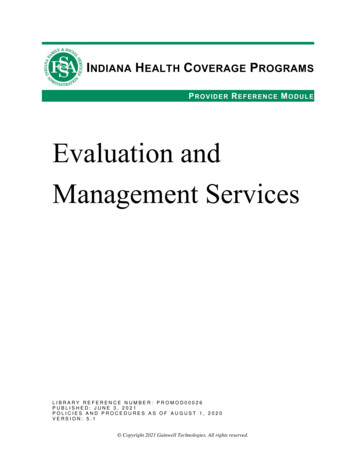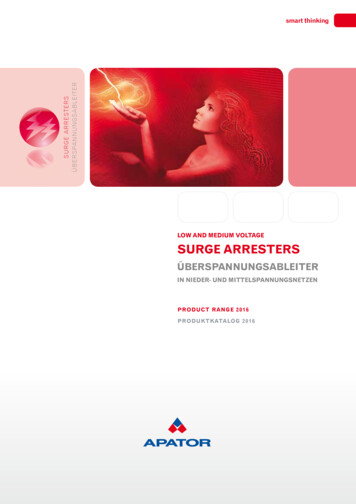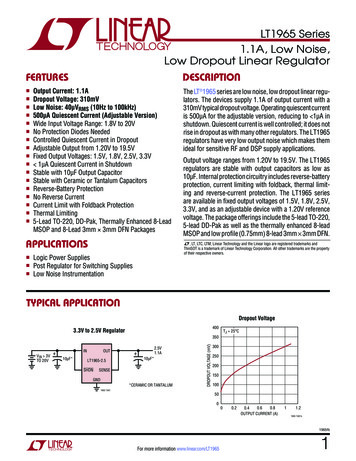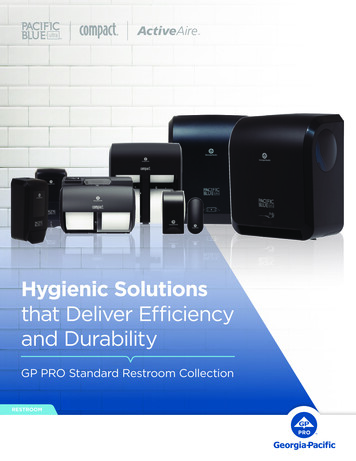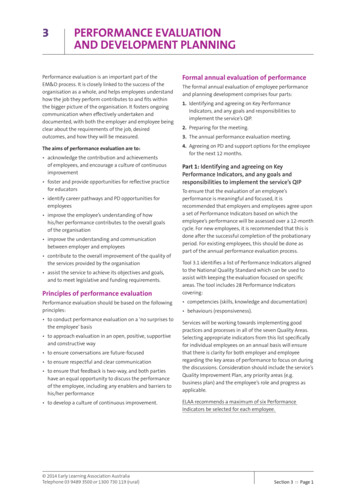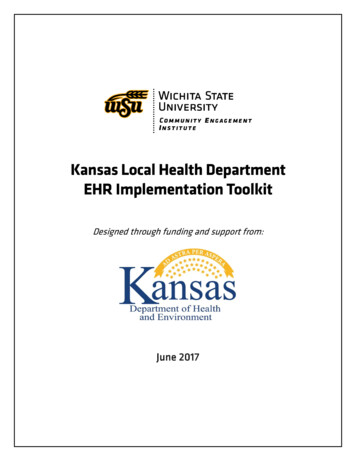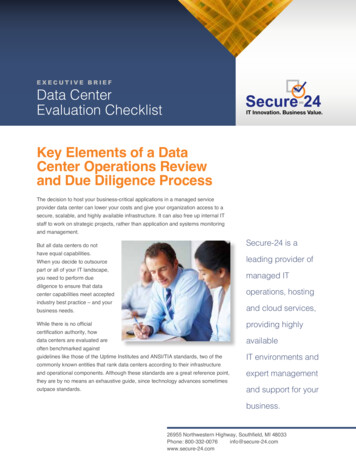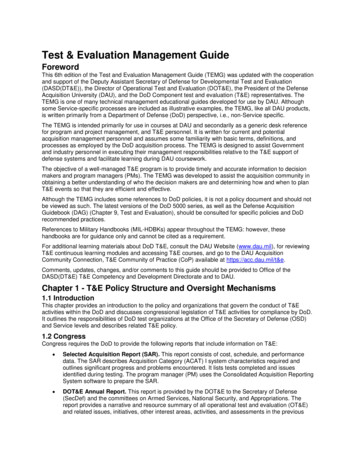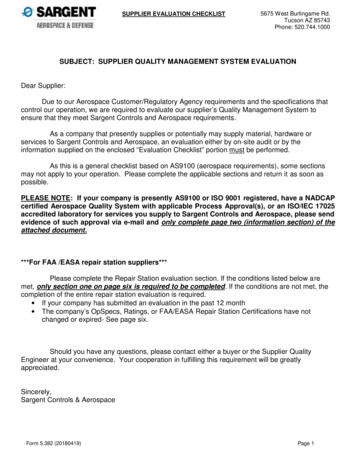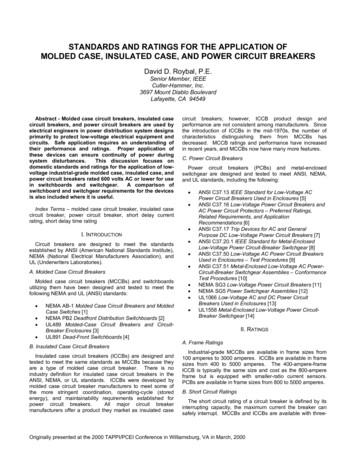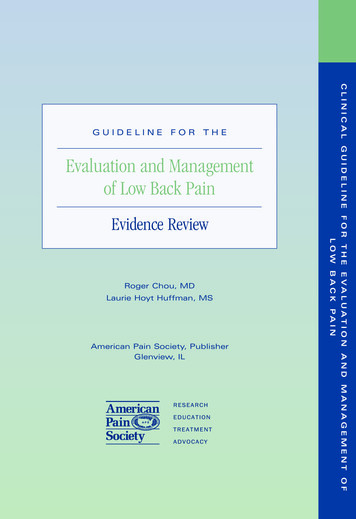
Transcription
fortheEvaluation and Managementof Low Back PainEvidence ReviewAmerican Pain Society, PublisherGlenview, ILL O W B A C K PA I NRoger Chou, MDLaurie Hoyt Huffman, MSC L I N I C A L G U I D E L I N E F O R T H E E VA L U AT I O N A N D M A N A G E M E N T O FGuideline
EVIDENCE REVIEWAPS Clinical Guideline for the Evaluation and Management of Low Back PainTABLE OF CONTENTSPageIntroduction1Purpose of evidence review .1Background1Previous guidelines.2Scope of evidence review4Key questions .4Populations .6Interventions .6Non-invasive interventions .6Invasive, non-surgical interventions .7Surgical interventions .8Invasive diagnostic tests .8Outcomes.8Conflict of interest .9Methods9Literature search and strategy .9Inclusion and exclusion criteria .10Data extraction and synthesis .11Systematic reviews.11Individual trials on efficacy and safety of interventions.11Observational studies of treatment efficacy.13Studies of invasive diagnostic tests.13Dual review .13Assessing research applicability and clinical relevance .13Data synthesis .14Rating of good quality.14Rating of fair quality.14Rating of poor quality .14Assessing magnitude of benefits or harms .15iAmerican Pain Society
EVIDENCE REVIEWAPS Clinical Guideline for the Evaluation and Management of Low Back PainTABLE OF CONTENTSPageResults16Size of literature reviewed.16Key Question 1a. How accurate are features of the history andphysical exam for predicting presence of serious underlyingconditions (“red flags”) or other conditions that may be responsiveto specific therapies in patients with low back pain (such as nerveroot compression or spinal stenosis)?.17Accuracy of history and physical exam features for identifyingspecific diagnoses associated with low back pain .18Cancer .18Infection .19Cauda equina syndrome.19Compression fracture .19Ankylosing spondylitis.19Herniated disk or radiculopathy .20Spinal stenosis .20Key Question 1b. How accurate are features of the history andphysical exam for predicting the development of persistent lowback pain and associated disability (“yellow flags”)?.23Accuracy of history and physical exam features for identifyingpatients more likely to develop chronic and disabling lowback pain.23Key Question 1 Summary Table:Systematic reviews of prognostic factors for identifying patientsmore likely to develop chronic and disabling low back pain .25Key Question 1c. How effective is identification and treatment ofyellow flags for improving clinical outcomes in patients with lowback pain?.29Efficacy of interventions for identifying and treating yellow flags.30Key Question 2a. How accurate are different diagnostic tests foridentifying serious underlying conditions (e.g., tumor, infection,compression fracture)? .34Accuracy of imaging for diagnosing cancer .35Accuracy of imaging for diagnosing vertebral infection .35iiAmerican Pain Society
EVIDENCE REVIEWAPS Clinical Guideline for the Evaluation and Management of Low Back PainTABLE OF CONTENTSPageAccuracy of imaging for diagnosing vertebral compressionfracture .35Accuracy of elevated erythrocyte sedimentation rate fordiagnosing cancer .36Key Question 2b. How accurate are different diagnostic tests foridentifying other conditions (e.g. nerve root compression,herniated disc, spinal stenosis) that may respond to specifictherapies? .37Accuracy of imaging for diagnosing nerve root compression,herniated disk, and spinal stenosis.37Accuracy of imaging for diagnosing ankylosing spondylitis .38Diagnostic accuracy of other (non-imaging) tests.38Key Question 2c. In patients with red flags, how effective aredifferent diagnostic tests for improving patient outcomes? .40Efficacy of diagnostic testing in patients with red flags .40Key Question 2d. In patients without red flags, how effective aredifferent diagnostic tests or test strategies (including no testing)for improving patient outcomes? .40Efficacy of routine, early plain radiography versus usual care orimaging only if clinically necessary (or without improvement) .40Efficacy of routine MRI versus MRI only if clinically necessary(or without improvement).43Efficacy of rapid MRI versus lumbar radiography in patientswith low back pain referred for imaging .43Key Question 3. How effective are self-care advice, education, orother self-care interventions for improving patient outcomes? .46Self-care advice or education .46Advice to rest in bed .46Advice to remain active.48Self-care back education books.53Self-care e-mail discussion groups .58Self-care exercise videotape.59Advice to restrict early morning flexion .60Lay-facilitated groups for self-care.61iiiAmerican Pain Society
EVIDENCE REVIEWAPS Clinical Guideline for the Evaluation and Management of Low Back PainTABLE OF CONTENTSPageSelf-help tools for back surgery decisions.62Other self-care interventions .64Lumbar supports.64Mattresses .65Superficial heat or cold .67Key Question 3 Summary Tables:Systematic reviews on efficacy of self-care therapies for lowback pain.70Summary of evidence on self-care therapies for acute lowback pain.72Summary of evidence on self-care therapies for chronic orsubacute low back pain .73Summary of evidence on self-care therapies for radiculopathyor sciatica .75Key Question 4. How effective are different non-invasiveinterventions for non-radicular low back pain, radicular low backpain, or spinal stenosis, and under what circumstances? .76Medications .76Acetaminophen.76Non-steroidal anti-inflammatory drugs (NSAIDs) .78Non-selective NSAIDs.78COX-2 selective NSAIDs.81Aspirin.82Other medications.83Antidepressants.83Benzodiazepines .86Antiepileptic drugs .87Skeletal muscle relaxants.90Opioid analgesics .92Tramadol .98Systemic corticosteroids.101Topical lidocane .103ivAmerican Pain Society
EVIDENCE REVIEWAPS Clinical Guideline for the Evaluation and Management of Low Back PainTABLE OF CONTENTSPageHerbal therapies .103Key Question 4 Summary Tables:Systematic reviews on efficacy of medications and herbaltherapies for low back pain.106Summary of evidence on medications and herbal therapies foracute low back pain.111Summary of evidence on medications and herbal therapies forchronic or subacute low back pain .113Summary of evidence on medications for sciatica or radicularlow back pain .115Acupuncture and related interventions .116Acupuncture and dry needling .116Acupressure.121Neuroreflexotherapy .122Educational interventions .124Back schools.124Brief educational interventions.126Exercise and related interventions .129Exercise .129Hydrotherapy .134Yoga .135Interdisciplinary interventions .137Interdisciplinary rehabilitation (multidisciplinary rehabilitation).137Functional restoration (physical conditioning, workconditioning, or work hardening).140Physical modalities.142Interferential therapy .142Low level laser therapy .144Shortwave diathermy .147Traction.149Transcutaneous electrical nerve stimulation (TENS) .151vAmerican Pain Society
EVIDENCE REVIEWAPS Clinical Guideline for the Evaluation and Management of Low Back PainTABLE OF CONTENTSPagePercutaneous electrical nerve stimulation (PENS) .153Ultrasound .156Other non-invasive interventions .157Psychological therapies .157Massage .159Modified work.162Spa therapy and balneotherapy.163Spinal manipulation .165Key Question 4 Summary Tables:Systematic reviews on efficacy of non-pharmacologic therapiesfor low back pain .172Summary of evidence on non-pharmacologic therapies foracute low back pain.185Summary of evidence on non-pharmacologic therapies forchronic or subacute low back pain .187Summary of evidence on non-pharmacologic therapies forradiculopathy or sciatica.190Key Question 5. How effective are decision tools or othermethods for predicting which patients are more likely to respondto specific therapies like spinal manipulation or different types ofexercise therapy?.191Reliability and validity of manual spinal palpatory exam orclinical tests of the sacroiliac joint.191Utility of clinical prediction rules for spinal manipulation.191Clinical prediction rules for exercise .193Patient classification systems for individualizing physicaltherapy interventions .193Key Question 6. How effective is referral from primary careproviders to back specialty providers for improving patientoutcomes? What are the outcomes for patients who are managedby different types of care providers or by multidisciplinary orinterdisciplinary clinics? .195viAmerican Pain Society
EVIDENCE REVIEWAPS Clinical Guideline for the Evaluation and Management of Low Back PainTABLE OF CONTENTSPageKey Question 7. What is the diagnostic accuracy and what arethe potential harms associated with invasive tests for identifyingpatients who may benefit from invasive procedures? Howeffective is prior use of these tests for selecting patients forinvasive procedures in improving outcomes? .197Provocative discography .197Diagnostic selective nerve root blocks .205Diagnostic intra-articular facet joint blocks and medialbranch blocks .206Diagnostic sacroiliac joint blocks .208Key Question 8. How effective are injections (and differentinjection interventions) and other interventional therapies for nonradicular low back pain, radicular low back pain, or spinalstenosis, and under what circumstances? .209Injections outside the spine .209Local injections .209Botulinum toxin .212Prolotherapy .213Intraspinal steroid injection and chemonucleolysis.215Epidural steroid injection.215Intradiscal steroid injection.234Chemonucleolysis.236Radiofrequency denervation, intradiscal electothermal therapy(IDET), and related procedures .243Radiofrequency denervation .243Intradiscal electothermal therapy (IDET) .249Percutaneous intradiscal radiofrequency thermocoagulation(PIRFT) and Coblation nucleoplasty .252Spinal cord stimulation.254Key Question 8 Summary Tables:Systematic reviews on efficacy of interventional therapies for lowback pain.256viiAmerican Pain Society
EVIDENCE REVIEWAPS Clinical Guideline for the Evaluation and Management of Low Back PainTABLE OF CONTENTSPageSummary of evidence on interventional therapies for lowback pain.269Key Question 9. How effective is surgery (and different surgicalinterventions) for non-radicular low back pain, radicular low backpain, or spinal stenosis, and under what circumstances? .272Surgery for non-radicular low back pain with commondegenerative changes .272Surgery for isthmic spondylolisthesis .279Surgery for spinal stenosis with or without degenerativespondylolisthesis .282Surgery for radiculopathy with herniated lumbar disc.291Key Question 9 Summary Tables:Systematic reviews on efficacy of surgery for low back pain .299Summary of evidence on surgery for low back pain .311Key Question 10. How effective are combinations of therapies foracute and chronic low back pain? .313Combinations of medications .313Self-care advice combined with other interventions .315Exercise combined with other interventions .317Acupuncture combined with other non-invasive interventions .319Spinal manipulation combined with other interventions.320Massage combined with other interventions.322Psychological therapies combined with other interventions .322Traction combined with other interventions .323Combination therapy for spinal stenosis.324Key Question 11. How effective are different treatment strategiesfor failed back surgery syndrome? .325Adhesiolysis and forceful epidural injection .325Intrathecal therapy.331Non-invasive interventions .333Spinal cord stimulation .334viiiAmerican Pain Society
EVIDENCE REVIEWAPS Clinical Guideline for the Evaluation and Management of Low Back PainTABLE OF CONTENTSPageKey Question 12. How effective are different methods ofintegrating or coordinating low back pain care? .336Key Question 13. How effective are interventions for secondaryprevention of low back pain in patients who have had an episodeof acute low back pain, or for prevention of flares of low back painin patients with chronic low back pain? .338Back schools .338Exercise.339Lumbar supports .341Advice to stay active.342Early occupational medicine intervention .343Psychological therapies, interdisciplinary rehabilitation, spinalmanipulation, acupuncture, patient information or education .344Key Question 14. How effective are interventions for managinglow back pain during pregnancy and post-partum?.344Acupuncture during pregnancy.344Physical therapy during pregnancy .346Massage during pregnancy .348Supportive devices during pregnancy .349Key Question 15. What is the cost-effectiveness associated withdifferent interventions or management strategies (such as careprovided by different types of providers) for managing low backpain? .350Summary and discussion350Research gaps.350ixAmerican Pain Society
EVIDENCE REVIEWAPS Clinical Guideline for the Evaluation and Management of Low Back PainTABLE OF CONTENTSPageBibliography .352APPENDICESAppendix 1: Systematic reviews search strategies .401Appendix 2: Primary studies search strategies.402Appendix 3: Systematic reviews quality rating system.419Appendix 4: Randomized controlled trials quality rating system .421Appendix 5: Quality ratings of included systematic reviews.423Appendix 6: List of excluded systematic reviews.436Appendix 7: Quality ratings of trials .449Appendix 8: Quality ratings of diagnostic accuracy trials .466Appendix 9: Systematic reviews published too recently to be includedin this evidence review.468Appendix 10: Glossary.469xAmerican Pain Society
EVIDENCE REVIEWAPS Clinical Guideline for the Evaluation and Management of Low Back PainINTRODUCTIONPurpose of evidence reviewThis evidence review focuses on evaluation and management of low back pain in adults. TheAmerican Pain Society (APS), which commissioned this report, used it to develop evidencebased clinical practice guidelines on evaluation and management of low back pain. Theguidelines were developed in two stages. The first stage, published in October 2007, focusedon initial (primary care) evaluation and management of low back pain, and was conducted inpartnership with the American College of Physicians1. The second stage, published in May2009, focused on use of interdisciplinary rehabilitation, interventional therapies, and surgery forlow back pain2.BACKGROUNDLow back pain is extremely common. Though estimates vary widely, studies in developedcountries report point prevalences of 12% to 33%, one-year prevalences of 22% to 65%, andlifetime prevalences of 11% to 84%3. In the U.S., nonspecific mechanical low back pain is thefifth most common reason for all physician visits, and the second most common symptomaticreason, accounting for approximately 2.3% of all physician visits4, 5. About one-quarter of U.S.adults report low back pain lasting at least a whole day in the last three months5. 7.6% of U.S.adults randomly surveyed by telephone had at least one occurrence of severe acute low backpain during a one-year period, with 39% of those seeking medical care for the episode6.Low back pain is also very costly. In 1998, total health care expenditures incurred by individualswith back pain in the U.S. were 90.7 billion, with incremental costs attributed to back pain 26.3 billion7. Medical treatment for chronic low back pain is estimated to cost 9,000 to 19,000 per patient annually, and interventional treatments cost a minimum of 13 billion in19908. Additional costs are associated with days lost from work due to low back pain. Lowback pain is the most common cause for chronic or permanent impairment in U.S. adults underthe age of 65, and the most common cause of activity limitations in persons under the age of459. Between 2% and 8% of the U.S. work force is disabled or compensated for back injurieseach year8, 9. Approximately 5% of people with back pain disability are thought to account for75% of the costs associated with low back pain10.Many patients with acute episodes of low back pain do not seek care because symptoms areoften brief and self-limited. Among those who do seek medical care, rapid improvements inpain (average improvement of 58% of initial score), disability (average improvement of 58%),and return to work (82% of those initially off work return to work) are seen in the first month11.Further improvement generally occurs through approximately three months, after which pain ordisability levels and rates of return to work tend to remain relatively constant. Up to one-third ofpatients report persistent back pain of at least moderate intensity one year after an acuteepisode requiring care, and one in five report substantial activity limitations12. Recurrences ofpain also are common, with 60% to three-quarters of patients experiencing at least one relapse1American Pain Society
EVIDENCE REVIEWAPS Clinical Guideline for the Evaluation and Management of Low Back Painwithin 12 months11, 13. Factors associated with the development of chronic disability due to lowback pain include pre-existing psychological conditions and distress, presence of other types ofchronic pain, job dissatisfaction or stress, and disputes over compensation issues14.Many options are available for the evaluation and management of acute or chronic low backpain. However, there has been little consensus, either within or between specialties, onappropriate uses of diagnostic tests15 and interventions16. This is demonstrated by numerousstudies showing unexplained variations in use of diagnostic tests and treatment. The rate ofback surgery in the U.S., for example, is over five times
physical exam for predicting presence of serious underlying conditions (“red flags”) or other conditions that may be responsive . Self-care back education books.53 Self-care e-mail d


